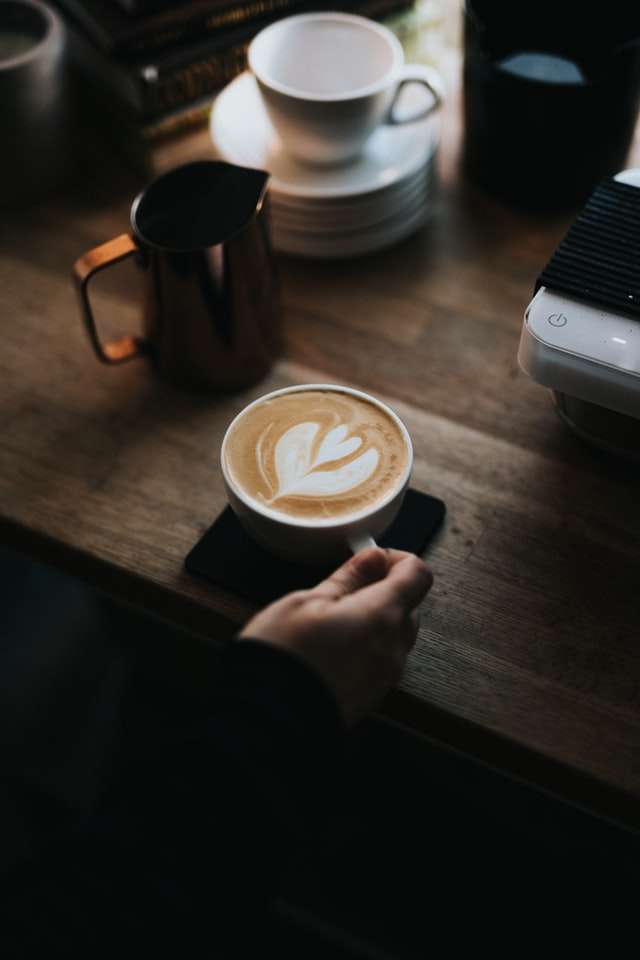Where do passion, creativity, and coffee seams meet? Cafe art of course! From the reclaimed wood covered with paint splashes painted on the walls to the latte art on top of your cappuccino – hospitaltity knows no bounds. And unapologetically so.
The diversity it encompasses, the variety one can observe during a visit, and the amount of talent it cultivates – these 3 combined elements eat up all others in terms of uniqueness and aesthetic appeal.
Table of Contents
Get inspiring
When you go to a cafe, you may be looking for more than a cup of coffee. You feel like getting some work done, but the place is loud and crowded and not conducive to concentration. What do you want?
You want a good place to write: no frills, quiet, and maybe even dim lighting. You want coffee and snacks: decent quality and not too pricey. You want to interact with other people: enough of them to get your creative juices flowing, but not so many that you feel distracted from your work.
And you want these things in such a way that they don’t fight each other. You don’t want such poor food that you spend all your time thinking about where else you could have eaten instead; but if the food is so delicious that it distracts you from your work, what’s the point?
The reason I’m describing this imaginary cafe is that no such place exists in real life. And yet if it did exist, everyone would flock there. So why doesn’t anyone create it?
Because it’s hard to get right. It’s hard to make a good cafe, because there are many conflicting demands. To get started making one requires not just a general mastery of hospitality, but also an intuitive understanding of crowd.
When you start a small business, it’s not just your passion that keeps you going. It’s also that you know exactly what to do to make it succeed.
Your knowledge of the business is the ultimate competitive advantage. If you’re smart enough to start a cafe, other people aren’t going to be able to compete with you. And if you know how to run a cafe, it has whatever business advantages cafes have — space, location, equipment — to work for you.
But wait. If everyone knows what makes a good cafe, why isn’t everyone running one? If everyone knew how to make money in stocks, they’d all be rich. The answer is that no one knows how to start a business or pick stocks or any of the other complicated things successful people do. Knowledge only becomes an advantage when combined with action.
Have a theme
A cafe with a theme is more than just decor. It tells you what to expect, and it allows you to feel good about the things you find there.
Cafe Art is in many ways a traditional cafe. There’s lots of seating. The tables aren’t too close together. There are newspapers and magazines to read. There are small pastries; the kitchen makes sandwiches; the coffee is good. And if you want to work, they have power outlets everywhere.
But it’s also clearly not like any other cafe I’ve ever been in, because it has a theme, which is art. Specifically, art by local artists, but without any of the self-consciousness you might expect from an art cafe (even though it sometimes feels like one).
The walls are covered in paintings and drawings and photos, all for sale (the prices are low–most are $20 or less). The chairs are interesting shapes, painted in bright colors. And when you order food or coffee or tea, there are no menus–just send your waiter to the counter at the back of the room.
This is not just a cafe for people who want to be left alone with their laptops or their books or even with their friends; it’s a place where everyone sits in.
Create a space that reflects who you are
Cafes are not like restaurants, or like bars. Cafes are like living rooms. They should feel like the kind of place that you would be happy to hang out in all day, if you didn’t have to go to work. They should feel like the kind of place where it would be fun to bring people you wanted to impress.
Cafe Art is about making cafes more like living rooms, and less like restaurants or bars. It’s about making them more welcoming, more comfortable, and more engaging.
It’s also about creating places where interesting things happen. The best cafes are not just settings for anonymous consumption; they are social spaces that reflect the personality of their owners.
And finally it’s about building community: coffee shops are gathering places, and their success depends on the relationships they help form between customers and baristas, between regulars and new arrivals.
In the end, though, what matters is not the color of the chairs or even who designed them. What matters is that they are there to bring people together, and that the cafe is a place where people naturally want to come together.
The cafe is for hanging out. It should be a place where you can see what’s going on in the world, meet people, and just generally relax. It should be open to everyone—you should never feel like you have to buy something to fit in. Cafe Art isn’t about selling coffee; it’s about creating an experience that reflects your values and connects with people.
Check out mugs, bowls and even bagels
The cafe’s main focus is on its art, but the art is just one of several elements that contribute to the cafe’s personality.
True to its name, Cafe Art serves up a rotating selection of local artists’ work. The pieces, but more importantly, they are displayed in the cafe in every way imaginable. Three-dimensional pieces are hung from the ceiling, others sit on pedestals or rest on tabletops. Some are framed under glass, while others are propped up by books or magazines. Some are accompanied by explanatory textboxes; others are left to speak for themselves.
Oversize paintings take up entire walls in one area, while small sketches hang in groups in another corner. A few pieces even hang from the ceiling above the counter where customers order their drinks and snacks.
Here you will find oil paintings, watercolors, sketches in pencil and pen, ceramics and much more. Local artists are encouraged to submit work to be considered for display in Cafe Art’s rotating collection.
Post inspirational quotes
I’ve been running a cafe for five years. Some people come in every day; they know their order and sit in the same spot. Others step inside once or twice; they read the menu and linger over the drinks. Still others are here for their one-time experience: they’re traveling through town, or on a date, or meeting friends.
One of my goals is to make customers feel at home. I want my customers to be comfortable enough that they can relax and enjoy themselves. But I also want them to understand that I am not trying to sell them anything except coffee and food, and kindness.
This is why I put inspirational quotes on the wall: so they will know that someone else out there has felt what they feel, and survived it without giving up hope.
Maybe they’ll see a quote that strikes a chord with them: “We don’t see things as they are, we see them as we are,” for example, or “Failure is an event not a person.” Or maybe there will be a quote that seems an odd fit: “I think we dream so we don’t have to be apart so long.”
Sometimes people ask me if I believe in these sayings. Do I believe that if you dream hard enough you won
Create pieces that aren’t only functional but decorative.
Functionality is great, but what if you want to serve more than coffee? If you want your cafe to be an inviting place as well as a functional one, it needs some atmosphere.
The problem with art, though, is that it costs money, and the amount of money you can charge per cup is limited. So the challenge is to create art that isn’t just functional and decorative — but cheap.
In cafes, people read, write, work on their laptops, talk with friends, study and relax. In short they create an atmosphere of comfort and added value. Cafe Art helps the establishment to project a creative image to its customers.
An important element of creating a successful cafe is providing an appropriate background that will allow customers to enjoy their drinks in a comfortable atmosphere. This is why the most attractive elements of each cafe are its details: a painting, a mirror or a clock.
The story of Cafe Art began when we realized that there was no one who offered quality paintings for cafe’s interior design. Being aware of this gap in the market we decided to do something about it.We started with the selection of painters from all over the world and now we try to make people around the globe fall in love with our art collection.
A cafe is a special kind of business: it is a place where people go to be around other people. This changes the way we think about the design of those places.
To maximize its trade, a restaurant can pack as many tables as possible into a given space. But to maximize the appeal of its trade, a cafe should leave some space empty. The goal is not simply to get as much money as possible out of the cafe, but to create an attractive environment, which will make customers want to come back. And if they want to come back, they will bring friends.
A cafe is where you go with your laptop or your sketch pad or your knitting or your friends or even just yourself. It is not just for eating; it is for being. So it needs chairs that are comfortable enough to sit in for hours, and tables that are designed not only for eating but also for writing on, using laptops or sketch pads.
The cafe itself becomes part of the picture that attracts customers. Some cafes are famous not only because the coffee is good but because their look has become iconic — think Starbucks’s mermaid logo or the white-on-black Mondrian aesthetic of Stumptown Coffee Roasters .
Make sure all the elements work together to create a cohesive theme
All the elements in a cafe have to work together to create a cohesive theme. The tables and chairs, the music, the decoration — all of these things have to reinforce one another. And if you get it right, everyone from your customers to writers from national magazines will notice how well it works.
A cafe is a place where people want to hang out. It’s not just a place where they want to buy something and drink it somewhere else. That’s an important distinction. In Japan, for example, cafes that don’t serve any food are common. But they wouldn’t work here in America, because we expect cafes to be gathering places with a focus on the quality of the experience rather than on efficiency or cost-effectiveness.
The coziness of a cafe is created in many different ways in many different cafes. One way is in the physical design: soft lighting, comfortable chairs (or stools), maybe some plants or artwork on the walls. Another is through the music: maybe some low-key jazz or classical music playing quietly in the background. There may be other things as well; these are just examples.
There are a lot of elements that go into making a great cafe, and it’s important to make sure that each is working with the others in a cohesive way. If they’re not, the cafe will feel disjointed and off-balance.
I think of this as Cafe Art. Some elements of the cafe are like pieces of art: they look good by themselves but don’t fit in with anything else. Others are more like musical instruments: they only sound good when you have a bunch of them playing together in harmony.
A cafe needs both kinds of elements, just like art does. Each one should pull its own weight and contribute to the whole. The question is whether they actually do that or get in each other’s way.
Bring color into your cafe
Get to know your customers
If you’re a small business owner, your job is to make the customers happy.
The best way to do that is to know your customers as individuals, and make them feel like you care about their well-being. The more time you spend with them, the more you learn about them and their problems and desires, and the better you can meet those needs.
If you are running a cafe or coffee shop, there is no one better suited to give you advice than the regulars. These are your patients, your customers, and arguably your friends. They know your product inside out. They probably know what you are doing right, but they are also very likely to know what you are doing wrong, because they have been part of it.
What I have found is that most cafes don’t value this advice very highly, regardless of whether they are independent or corporate. But it doesn’t have to be so. If you treat the habits and opinions of your regulars as highly valuable resources, and listen to them with an open mind and a humble heart, you might be surprised how many of them will give back to you in kind.
And if you can do that well enough, then we who visit will see your cafe as something more than just a place to buy coffee: as somewhere as lively as our own homes.
Keep the space as basic as possible
A cafe is a public place, and it needs to be inviting for strangers. But at the same time, you want it to be comfortable for regulars. And the two are not the same. I think of this as one of my laws, though I can’t remember where I first learned it.
The more welcoming you make the space, the more comfortable you will be for strangers, but also the less comfortable it will be for regulars.
The more focused you keep the space, the more comfortable it will be for regulars, but also the less welcoming you will be to strangers.
A great cafe has both qualities: it is inviting to strangers and comfortable to regulars. But they are in tension with each other. The best cafes strike a balance between them, and that balance shifts during the course of a day. The more successful your cafe becomes, the more this law applies; there will be more people who know each other and fewer who don’t.
Include your passion or skills some where in the cafe
We all have a love for something, a skill that we have practiced a lot and that gives us immense satisfaction. But often we keep quiet about it because we feel it is not “practical”. So it sits there, flashing in our minds, reminding us of the talents we have buried under the list of things to do.
To be happy at work, it helps to include something you love or are good at. This is because you will look forward going to work to do this thing, and people who enjoy their work are generally more productive. If you have any doubts about this, just think how enjoyable your day would be if you had a job where you got to play with kittens all day.
Instead of keeping quiet about your passions or skills, try talking about them with your colleagues or boss even if they don’t seem to share your enthusiasm. You never know what connections you can make by sharing what you like.
If you want to be really productive and happy at work, find the intersection between your passion and skills. Then , start working on projects that require both of them. For example if you are passionate about music and good at programming then work on an app that allows users to compose music by choosing different samples and arranging them in a sequence.
Make your establishment famous by using the right nouns
Nouns are the first line of your advertisement. The words you use to talk about your business are the first thing people will notice, and you want them to make a good impression.
I’m not saying that if you call yourself a cafe instead of a restaurant, or an art gallery instead of a shop, you are guaranteed success. But if you are starting from scratch, choosing the right nouns is one way to get your business noticed.
A new cafe or restaurant or art gallery will not compete against established businesses with long track records. It has no reputation to protect. It can set out to be deliberately different, aiming for customers the others have overlooked. And it can use its name to signal what makes it different.
If your business is really high-quality, people will know anyway, and the name won’t affect them. But for most businesses most of the time, especially new ones, a memorable name is an important part of their strategy for getting attention.



